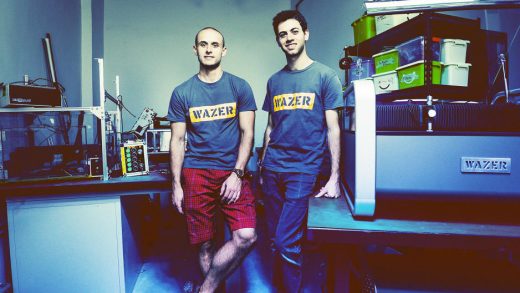Life Inside A Shenzhen Hardware Accelerator
Late in 2015, Bronx native Nisan Lerea and a friend toiled away in Lerea’s parents’ basement on a waterjet cutter, an effort that began as a senior thesis project at the University of Pennsylvania’s School of Engineering and Applied Science. Now he’s 8,000 miles away in Shenzhen, China, sharing an apartment with three colleagues, trying to turn the prototype into a commercial success.
Lerea’s company, Wazer, joined HAX, a venture-capital firm and hardware accelerator. “We got excited about the idea of doing development in China because we knew we were going to have to rely on the supply chain here,” he says.
Wazer’s 3′-by-2′ waterjet cutter costs less than $5,000, sits on a desktop, makes digital cuts, and is geared toward small businesses, artists, custom mechanics, automotive hobbyists, and tinkerers who perform these functions manually. Capable of cutting through glass, ceramic tile, stone, carbon fiber, copper, steel, titanium, and other hard materials, its cutting functions are otherwise available only from industrial-scale machines that cost between $100,000 and $1 million.
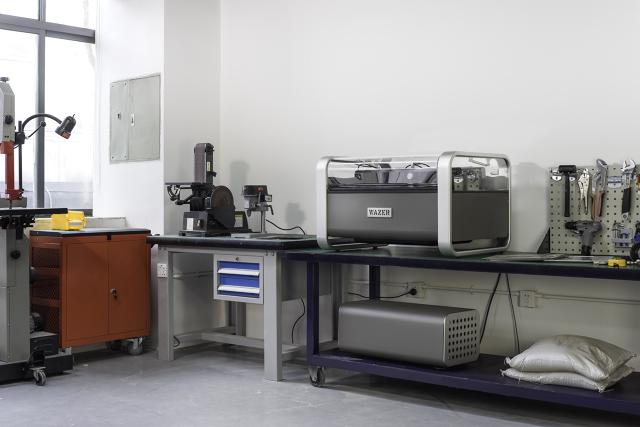
At HAX, Wazer shares space with other lifestyle, medical devices, robotics, infrastructure, and advanced fabrication hardware startups in the center of the world’s hardware capital, Shenzhen. A short bus ride north of Hong Kong, Shenzhen was designated as a Special Economic Zone by the Chinese government in 1980 and transitioned from an assemblage of fishing villages into a manufacturing hub making the world’s clothes, furniture, jewelry, and toys. Accordingly, its population skyrocketed from 30,000 in 1980 to as many as 20 million today. And its annual GDP exceeds that of the Republic of Ireland, Finland, and Greece.
Now Shenzhen is being reinvented as an entrepreneurial city, leveraging its manufacturing background, technologically adept labor pool, billions of dollars in foreign direct investment, and youthful demographic. (The average age of residents is below 30 years old.) Innovative industries such as biotechnology, green energy, communications technology, and new materials now account for 40% of the city’s economic output. Shenzhen’s R&D investment is approximately double the Chinese city average and it typically leads the country in patent applications. And in 2008, it was designated as a UNESCO City of Design.
A Place To Get Stuff Done
Although innovation is spreading throughout China, Shenzhen had a head start. Speaking about connected hardware, Duncan Turner, managing director at HAX, says that the city is “always going to have an unfair advantage over anywhere else.” There are pockets of innovation elsewhere, such as smart fabrics in Suzhou and materials in rural parts of the country. “But it’s never going to be as big as what’s going on here,” Turner says.
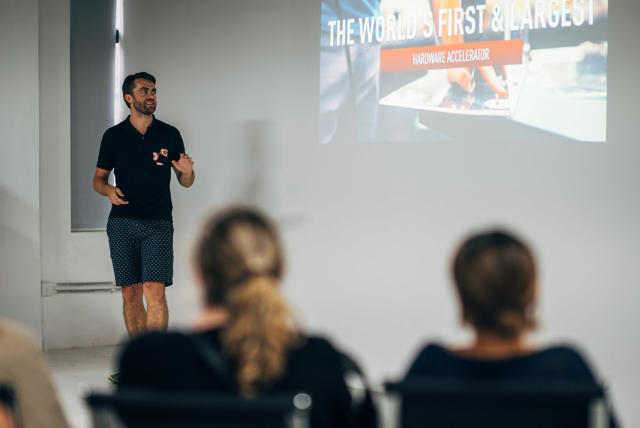
China’s top-down government policies have benefited growth, and so too has entrepreneurialism. Turner, a U.K. native, has lived in China for eight years and observed Shenzhen’s evolution. Historically, he says, large foreign companies knew how to deal with local wholesalers for parts, but startups had difficulties. That has changed over the last few years. “Now, this is the easiest place by far to get any of that stuff done. Suppliers are used to dealing with startups…There’s a whole lot of building blocks there to enable a startup to move quickly,” he says. “It’s a pretty friendly environment to get stuff done. People just want to do business.”
Innumerable makers, designers, manufacturers, wholesalers, and shippers have formed a hardware ecosystem in Shenzhen where creating is only constrained by one’s imagination, and HAX is located at the epicenter of it. Its proximity to a wide selection of inexpensive components suppliers reduces development time for startups. “It’s really valuable to be able to design a machine while being close to those vendors,” says Lerea.
In Shenzhen, says Vienna native Julia Kaisinger—the cofounder of Livin Farms, another HAX company—entrepreneurs can visit factories to inspect product quality and working conditions. And suppliers offer immediate product feedback and insights into manufacturing possibilities. “When you are here, you start building up a relationship because they want really to earn money with you,” she says. By interacting with suppliers, she adds, a startup can “treat them as a partner. Not just as some Chinese factory where you give them as little money as possible.”
With new products, problems with prototypes are inevitable, Kaisinger says, and they can be remedied in a day in Shenzhen, faster than elsewhere else. “And time’s super important right now,” she says. “Who has the time to wait three weeks to see if this thing is working or not?”
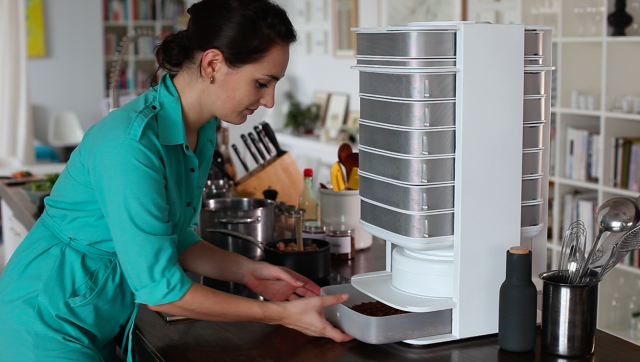
Livin Farms created a 2′-by-1′ soil-less, sensor-controlled, temperature-regulated, closed lifecycle to raise edible mealworms indoors. The mealworms are cultivated using kitchen scraps, reducing waste and giving users an understanding of what is going into their food. The microclimate is an alternative to industrialized meat production options and Livin Farms decided to go the insect route because, as Kaisinger said, “You can’t really put chicken or a pig in your apartment.”
Harvested mealworms are prepared in different fashions. When dry roasted and lightly salted, they taste similar to sunflower seeds, nutty and neutral. Kaisinger said people are hesitant at first, “But once they taste it, they really love it. And it’s super healthy.” She puts dry-roasted mealworms in salads, breads, cakes, yogurt, and granola. Prepared differently, they are meatier and can be made into burgers and mincemeat. “There’s so much potential,” she says.
Barriers, Language and Otherwise
Although creating a company in Shenzhen offers many advantages, it also has its impediments. Entrepreneurs must use VPNs (“virtual private network”) to circumvent the government-imposed censorship of the Great Firewall of China. Internet access, Lerea says, is “slow and unstable and unreliable. And just a constant frustration.”
Neither Lerea nor Kaisinger read, write, or speak Chinese. Google Translate helps with translations, but Lerea said, the biggest challenge is “definitely still the language barrier,” particularly when buying parts online. What could be ordered on Amazon in minutes may take an hour in China. Owing to the translation hurdle, Lerea said his company has “bought hundreds and hundreds of parts of all different shapes and sizes.”
Kaisinger agrees: “A lot of stuff gets lost in translation…Sometimes, parts just arrive not the way you want them to.” She adds, however, “You can get over it.” She communicates with pictures and said larger factories have English-speaking representatives. Local HAX staffers also help out. She talked about difficulty buying a SIM card and says “These are super-simple things, but it’s really convenient to have people around who support you with this.”
Kaisinger is studying Chinese, but said, “It’s coming slowly…I don’t really have time. Time is so precious. I put most of my time into learning about manufacturing.”
Beyond language, life requires other adjustments. Lerea shares an apartment with co-workers and gets around on the subway, a bike, and hoverboard. Regarding adapting to life in Shenzhen, he says “It’s a challenge, but I think that we feel we have a decent handle on it now. We know local places to eat. We know how to navigate the city.”
When hunting for housing options, Kaisinger said the guidance HAX provided was valuable because without connections, “[landlords] charge foreigners more.” To help her learn Mandarin, Kaisinger lives with local women not associated with the accelerator.
Kaisinger became intrigued with China during her first trip five years ago and is now maximizing the scarce time she spends away from the office. On weekends, she hikes and bikes. “China is just so big and has this surprisingly beautiful countryside. And this very interesting divergence where it’s at the same time kind of communist and capitalist,” she remarked.
She explained that in a globalizing world, “China is one of the few countries in the world where you very strongly feel as a foreigner…It has its very strong own culture…[Chinese] have a very unique way how they see life and how they interact with each other.” As an escape, she visits Hong Kong, which is more international.
For startups, Turner said, “The cultural problems are more of challenge than the language problems. It’s the main reason why [HAX is] here, really, is to help them get ahead. And we’re still learning how to do it, really well…It’s definitely a learning curve.”
UN For Startups
Although the city’s language, culture, and environment differ, entrepreneurs spend most of their time in HAX’s new 18,000-sq.-ft. office, where the accelerator’s composition resembles that of the UN with 55% of the companies coming from North America, 20% Europe, and 25% Asia. The office’s center is a large open space with dozens of parallel computer workstation rows. Offshooting this area are conference rooms, napping spaces, and a large kitchen and dining area with a ping-pong table. The area also has a workshop with laser cutters, 3D printers, various metal working machines, and equipment for environmental control and electrical compliance testing.
Company founders typically spend six or seven days in the office, 12-14 hours per day or more during media blitzes and fundraising stages. During hectic months, Kaisinger says that she works “Monday to Sunday, 8:00 a.m. in the morning til 3-4 a.m.”
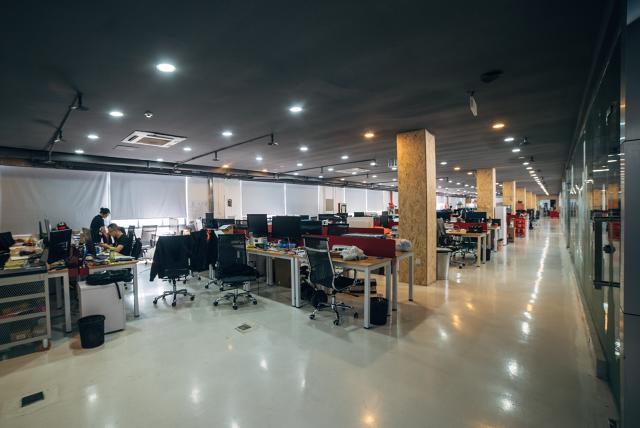
Besides space and capital, HAX offers other services useful for budding entrepreneurs, including business-plan development, pitch preparation, government-relations management, and mentoring. The accelerator also brings in experts in fields including manufacturing, robotics, electronics, engineering, industrial design, sourcing, branding, graphics, video making, and storytelling.
Kaisinger appreciates “being in this environment here with other startups. Learning from the other teams.The main advantage is really the drive you get here. The environment from the other people. And it really pushes you. You’re not left alone somewhere. You feel something is happening here.”
In exchange for 9%t of startups’ equity, HAX gives them $100,000 in funding. And after the HAX program, startups often crowdfund. According to Turner, HAX accounts for 1.5% and rising of total funding for Kickstarter projects, and 5% of Design & Technology projects that raise above $1 million.
Using this model, Hax successes include Makeblock, which manufactures programmable robotic kits; Next Thing Co., which made the first $9 computer; BBB, which provides mobile blood testing; Revols, which makes custom-fit earphones; and Dispatch, which is creating a self-driving delivery vehicle.
Kaisinger hopes Livin Farms will replicate these results and has enjoyed the adventure thus far. She appreciates the entrepreneurial community and said, “It’s really a lot more fun if you have people around you who are in a similar situation or have been.”
Fast Company , Read Full Story
(71)

